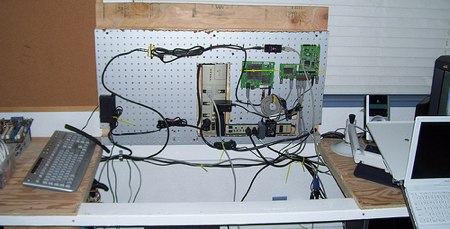
Though much of [citizenFinerran]’s intent in designing a suit that camouflages the wearer from security camera footage was philosophical, it is designed with a very tangible purpose in mind. The suit does not provide true camouflage (to say nothing of true invisibility), but it does create enough moving visual obstructions to make the wearer completely anonymous on film. More details on this and other invisibility cloaks after the break.
Misc Hacks4191 Articles
Hacking Sleep Part Deux

The Boston Globe recently posted some tips to help you get the most from your naps. The information comes in the form of a chart with numerous facts about naps, including the timeline of events in a typical nap, information about chronotypes, and ideas on how to fall asleep quickly and stay asleep. Since our post on polyphasic sleep, we’ve been interested in sleep techniques that essentially trick the body into feeling as rested as possible (the crudest form of biohacking, in our opinion). Many of these techniques are certainly applicable to polyphasic sleep, but one of the most interesting concepts, chronotypes, is not. Chronotypes are simply profiles of sleep habits that denote the times a person’s body is more readily disposed to fall asleep; since polyphasic sleep requires practitioners to sleep several times a day, it is always in conflict with the person’s chronotype at some point in the day. Nonetheless, the chart should help you stay alive if you ever have several back-to-back intercontinental flights.
[via Lifehacker]
Twittering Teddy Bear
This may be the deathblow that kills Nabaztag: using text-to-speech software, this animatronic bear speaks a Twitter stream aloud and in real time.
The gurus at My Home 2.0 made the bear talk by replacing its integrated circuit board with an Arduino loaded with custom software. A Bluetooth audio adapter was added as a channel for the bear’s voice, and a circuit with an H bridge chip was added to address power issues. The Arduino translates the income audio signal into movement. From there the process moved to the computer that feeds the bear audio data, they parse the Twitter stream and use OSX’s built in “say” command to generate the voice stream that’s sent to the bear via Bluetooth.
Robot Chairs

Chairs may be among the most useful inventions known to humanity, but that doesn’t mean that a clever engineer or two can’t improve on the idea. As proof, we offer you this list of robotic chairs that do much more than provide a place to put your rear in.
Don’t Talk To The Police
As builders of improvised electronic devices, we’re worried that we may find ourselves running afoul of the law. Lucky for us, we’ve got the advice of Regent University Law Professor James Duane on using the 5th amendment. He runs through many examples where saying anything at all, truth or otherwise, can get you into trouble. Embedded below is the other side: Officer George Bruch discussing some of the interview techniques he uses.
Laser Based Night Light

[the4est] put together this quick how to for making a laser based light bulb night light. First, you need to break out the black glass base of the bulb and remove the filament. Scrub the inside of the bulb and pour in the paraffin. Once it sets, you can break the glass, leaving a solid wax bulb. Hollow out the inside, insert a laser pointer, and you’ll have fine glowing night light.
Pegboard Cable Organizer

In our integrated desk post, we mentioned using pegboards and zip ties to organize cables. Lifehacker has a collection of pictures from their readers that are using this solution. We especially love [Steve Price]’s fliptop solution pictured above. It may not look too attractive, but we’d do pretty much anything to avoid crawling under a desk.










